Correlation Study between the Organic Compounds and Ripening Stages of Oil Palm Fruitlets Based on the Raman Spectra
Abstract
:1. Introduction
2. Materials and Methods
2.1. Oil Palm Fruit Samples Preparation
2.2. Raman Instrumentation
2.3. Raman Spectra Pre-Processing
2.4. Statistical Analysis
2.5. Classification Analysis
3. Results
3.1. Raman Spectra Pre-Processing
3.2. Features Extraction and Analysis
3.3. Statistical Analysis
3.4. Classification Analysis
4. Discussion
5. Conclusions
Author Contributions
Funding
Conflicts of Interest
References
- Mat Sharif, Z.B.; Mohd Taib, N.B.; Bin Yusof, M.S.; Bin Rahim, M.Z.; Bin Mohd Tobi, A.L.; Bin Othman, M.S. Study on Handing Process and Quality Degradation of Oil Palm Fresh Fruit Bunches (FFB). IOP Conf. Ser. Mater. Sci. Eng. 2017, 203, 12027. [Google Scholar] [CrossRef]
- Sabri, N.; Ibrahim, Z.; Isa, D. Evaluation of color models for palm oil fresh fruit bunch ripeness classification. Indones. J. Electr. Eng. Comput. Sci. 2018, 11, 549–557. [Google Scholar] [CrossRef]
- Alfatni, M.S.M.; Mohamed Shariff, A.R.; Bejo, S.K.; Ben Saaed, O.M.; Mustapha, A. Real-time oil palm FFB ripeness grading system based on ANN, KNN and SVM classifiers. IOP Conf. Ser. Earth Environ. Sci. 2018, 169, 12067. [Google Scholar] [CrossRef]
- Makky, M.; Cherie, D. Pre-harvest oil palm FFB nondestructive evaluation technique using thermal-imaging device. IOP Conf. Ser. Earth Environ. Sci. 2021, 757, 12003. [Google Scholar] [CrossRef]
- MPOB. Oil Palm Fruit Grading Manual; Malaysian Palm Oil Board (MPOB): Kajang, Selangor, 2003; ISBN 9679610918. [Google Scholar]
- Bensaeed, O.M.; Shariff, A.M.; Mahmud, A.B.; Shafri, H.; Alfatni, M. Oil palm fruit grading using a hyperspectral device and machine learning algorithm. IOP Conf. Ser. Earth Environ. Sci. 2014, 20, 12017. [Google Scholar] [CrossRef]
- Trebolazabala, J.; Maguregui, M.; Morillas, H.; de Diego, A.; Madariaga, J.M. Portable Raman spectroscopy for an in-situ monitoring the ripening of tomato (Solanum lycopersicum) fruits. Spectrochim. Acta Part A Mol. Biomol. Spectrosc. 2017, 180, 138–143. [Google Scholar] [CrossRef]
- Nekvapil, F.; Brezestean, I.; Barchewitz, D.; Glamuzina, B.; Chiş, V.; Cintă Pinzaru, S. Citrus fruits freshness assessment using Raman spectroscopy. Food Chem. 2018, 242, 560–567. [Google Scholar] [CrossRef]
- Raj, T.; Hashim, F.H.; Huddin, A.B.; Hussain, A.; Ibrahim, M.F.; Abdul, P.M. Classification of oil palm fresh fruit maturity based on carotene content from Raman spectra. Sci. Rep. 2021, 11, 18315. [Google Scholar] [CrossRef]
- Wahhiddan, N.; Hanim Hashim, F.; Raj, T.; Baseri Huddin, A. Optimization of Raman Spectra Peak Fitting for Oil Palm Classification. In Proceedings of the 2022 IEEE 18th International Colloquium on Signal Processing & Applications (CSPA), Selangor, Malaysia, 12 May 2022; pp. 320–324. [Google Scholar]
- Tzuan, G.T.H.; Hashim, F.H.; Raj, T.; Baseri Huddin, A.; Sajab, M.S. Oil Palm Fruits Ripeness Classification Based on the Characteristics of Protein, Lipid, Carotene, and Guanine/Cytosine from the Raman Spectra. Plants 2022, 11, 1936. [Google Scholar] [CrossRef]
- Trebolazabala, J.; Maguregui, M.; Morillas, H.; De Diego, A.; Madariaga, J.M. Use of portable devices and confocal Raman spectrometers at different wavelength to obtain the spectral information of the main organic components in tomato (Solanum lycopersicum) fruits. Spectrochim. Acta Part A Mol. Biomol. Spectrosc. 2013, 105, 391–399. [Google Scholar] [CrossRef]
- Koyama, Y.; Umemoto, Y.; Akamatsu, A.; Uehara, K.; Tanaka, M. Raman spectra of chlorophyll forms. J. Mol. Struct. 1986, 146, 273–287. [Google Scholar] [CrossRef]
- Jehlička, J.; Edwards, H.G.M.; Oren, A. Raman spectroscopy of microbial pigments. Appl. Environ. Microbiol. 2014, 80, 3286–3295. [Google Scholar] [CrossRef] [PubMed]
- Farber, C.; Li, J.; Hager, E.; Chemelewski, R.; Mullet, J.; Rogachev, A.Y.; Kurouski, D. Complementarity of Raman and Infrared Spectroscopy for Structural Characterization of Plant Epicuticular Waxes. ACS Omega 2019, 4, 3700–3707. [Google Scholar] [CrossRef]
- Tschirner, N.; Schenderlein, M.; Brose, K.; Schlodder, E.; Mroginski, M.A.; Thomsen, C.; Hildebrandt, P. Resonance Raman spectra of β-carotene in solution and in photosystems revisited: An experimental and theoretical study. Phys. Chem. Chem. Phys. 2009, 11, 11471–11478. [Google Scholar] [CrossRef]
- Lu, L.; Shi, L.; Secor, J.; Alfano, R. Resonance Raman scattering of β-carotene solution excited by visible laser beams into second singlet state. J. Photochem. Photobiol. B Biol. 2018, 179, 18–22. [Google Scholar] [CrossRef]
- Gupta, S.; Huang, C.H.; Singh, G.P.; Park, B.S.; Chua, N.H.; Ram, R.J. Portable Raman leaf-clip sensor for rapid detection of plant stress. Sci. Rep. 2020, 10, 20206. [Google Scholar] [CrossRef]
- Hernández, B.; Pflüger, F.; Kruglik, S.G.; Ghomi, M. Characteristic Raman lines of phenylalanine analyzed by a multiconformational approach. J. Raman Spectrosc. 2013, 44, 827–833. [Google Scholar] [CrossRef]
- Pan, J.; Shao, X.; Zhu, Y.; Dong, B.; Wang, Y.; Kang, X.; Chen, N.; Chen, Z.; Liu, S.; Xue, W. Surface-enhanced raman spectroscopy before radical prostatectomy predicts biochemical recurrence better than CAPRA-S. Int. J. Nanomed. 2019, 14, 431–440. [Google Scholar] [CrossRef]
- Contorno, S.; Darienzo, R.E.; Tannenbaum, R. Evaluation of aromatic amino acids as potential biomarkers in breast cancer by Raman spectroscopy analysis. Sci. Rep. 2021, 11, 1698. [Google Scholar] [CrossRef]
- Prinsloo, L.C.; Du Plooy, W.; Van Der Merwe, C. Raman spectroscopic study of the epicuticular wax layer of mature mango (Mangifera indica) fruit. J. Raman Spectrosc. 2004, 35, 561–567. [Google Scholar] [CrossRef]
- Yu, M.M.L.; Schulze, H.G.; Jetter, R.; Blades, M.W.; Turner, R.F.B. Raman microspectroscopic analysis of triterpenoids found in plant cuticles. Appl. Spectrosc. 2007, 61, 32–37. [Google Scholar] [CrossRef] [PubMed]
- Marshall, C.P.; Marshall, A.O. The potential of Raman spectroscopy for the analysis of diagenetically transformed carotenoids. Philos. Trans. R. Soc. A Math. Phys. Eng. Sci. 2010, 368, 3137–3144. [Google Scholar] [CrossRef] [PubMed]
- Bradley, M. Curve Fitting in Raman and IR Spectroscopy: Basic Theory of Line Shapes and Applications. 2007. Available online: https://assets.thermofisher.com/TFS-Assets/CAD/Application-Notes/AN50733_E.pdf (accessed on 1 June 2022).
- Gyakwaa, F.; Aula, M.; Alatarvas, T.; Vuolio, T.; Shu, Q.; Huttula, M.; Fabritius, T. Application of Raman spectroscopy for characterizing synthetic non-metallic inclusions consisting of calcium sulphide and oxides. Appl. Sci. 2020, 10, 2113. [Google Scholar] [CrossRef]
- Ikemefuna, J.; Adamson, I. Chlorophyll and carotenoid changes in ripening palm fruit, Elaeis guineënsis. Phytochemistry 1984, 23, 1413–1415. [Google Scholar] [CrossRef]
- Ng, M.H.; Choo, Y.M. Improved Method for the Qualitative Analyses of Palm Oil Carotenes Using UPLC. J. Chromatogr. Sci. 2016, 54, 633–638. [Google Scholar] [CrossRef]
- Sorrequieta, A.; Ferraro, G.; Boggio, S.B.; Valle, E.M. Free amino acid production during tomato fruit ripening: A focus on L-glutamate. Amino Acids 2010, 38, 1523–1532. [Google Scholar] [CrossRef]
- Astuti, I.F.; Nuryanto, F.D.; Widagdo, P.P.; Cahyadi, D. Oil palm fruit ripeness detection using K-Nearest neighbour. J. Phys. Conf. Ser. 2019, 1277, 12028. [Google Scholar] [CrossRef]
- Saleh, A.Y.; Liansitim, E. Palm oil classification using deep learning. Sci. Inf. Technol. Lett. 2020, 1, 1–8. [Google Scholar] [CrossRef]
- Shabdin, M.K.; Shariff, A.R.M.; Johari, M.N.A.; Saat, N.K.; Abbas, Z. A study on the oil palm fresh fruit bunch (FFB) ripeness detection by using Hue, Saturation and Intensity (HSI) approach. IOP Conf. Ser. Earth Environ. Sci. 2016, 37, 12039. [Google Scholar] [CrossRef]
- Silalahi, D.D.; Reaño, C.E.; Lansigan, F.P.; Panopio, R.G.; Bantayan, N.C.; Davrieux, F.; Caliman, J.P.; Yuana, Y.Y. Sudarno Near infrared spectroscopy: A rapid and non-destructive technique to assess the ripeness of oil palm (Elaeis guineensis Jacq.) fresh fruit. J. Near Infrared Spectrosc. 2016, 24, 179–190. [Google Scholar] [CrossRef]
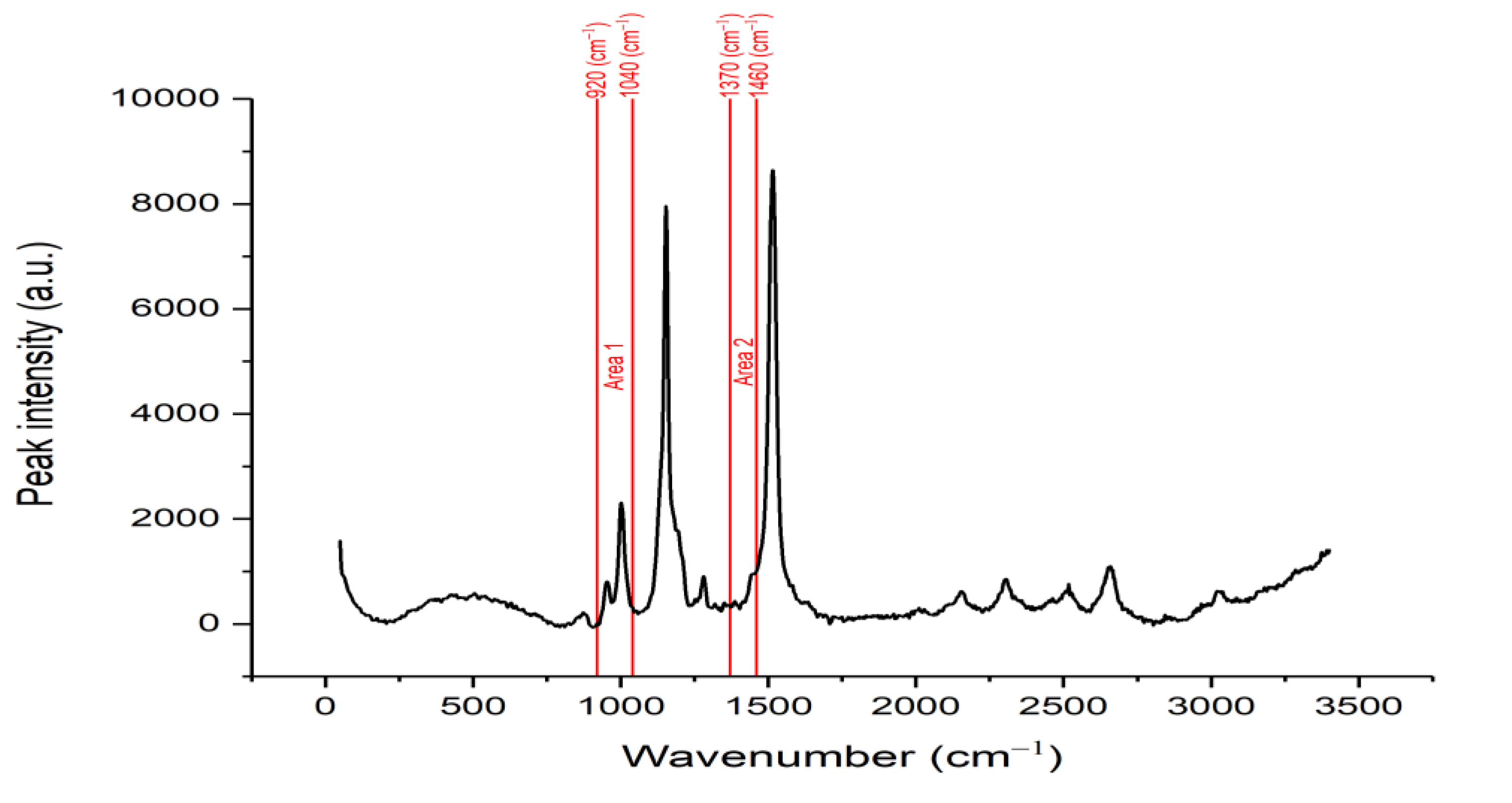



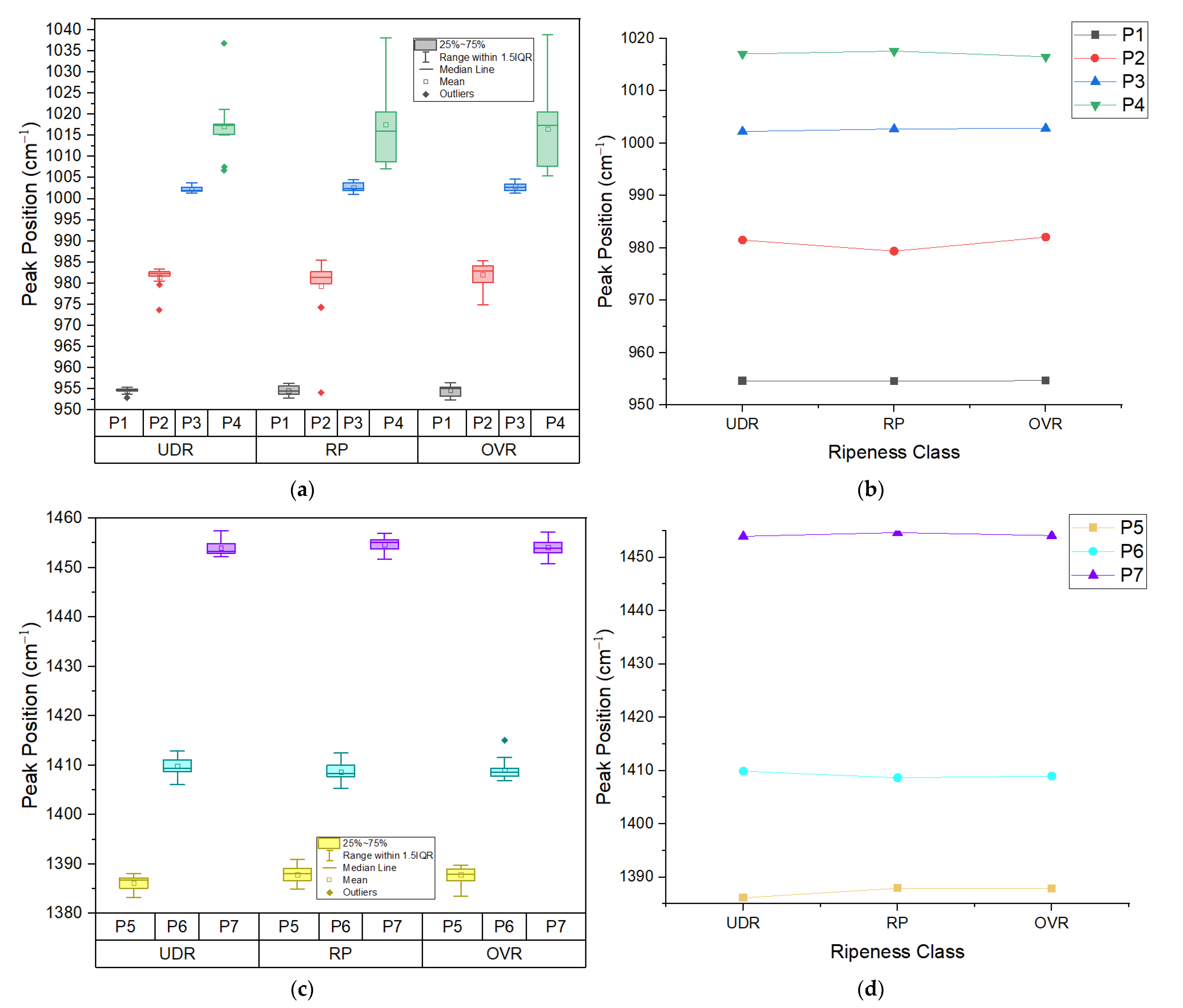
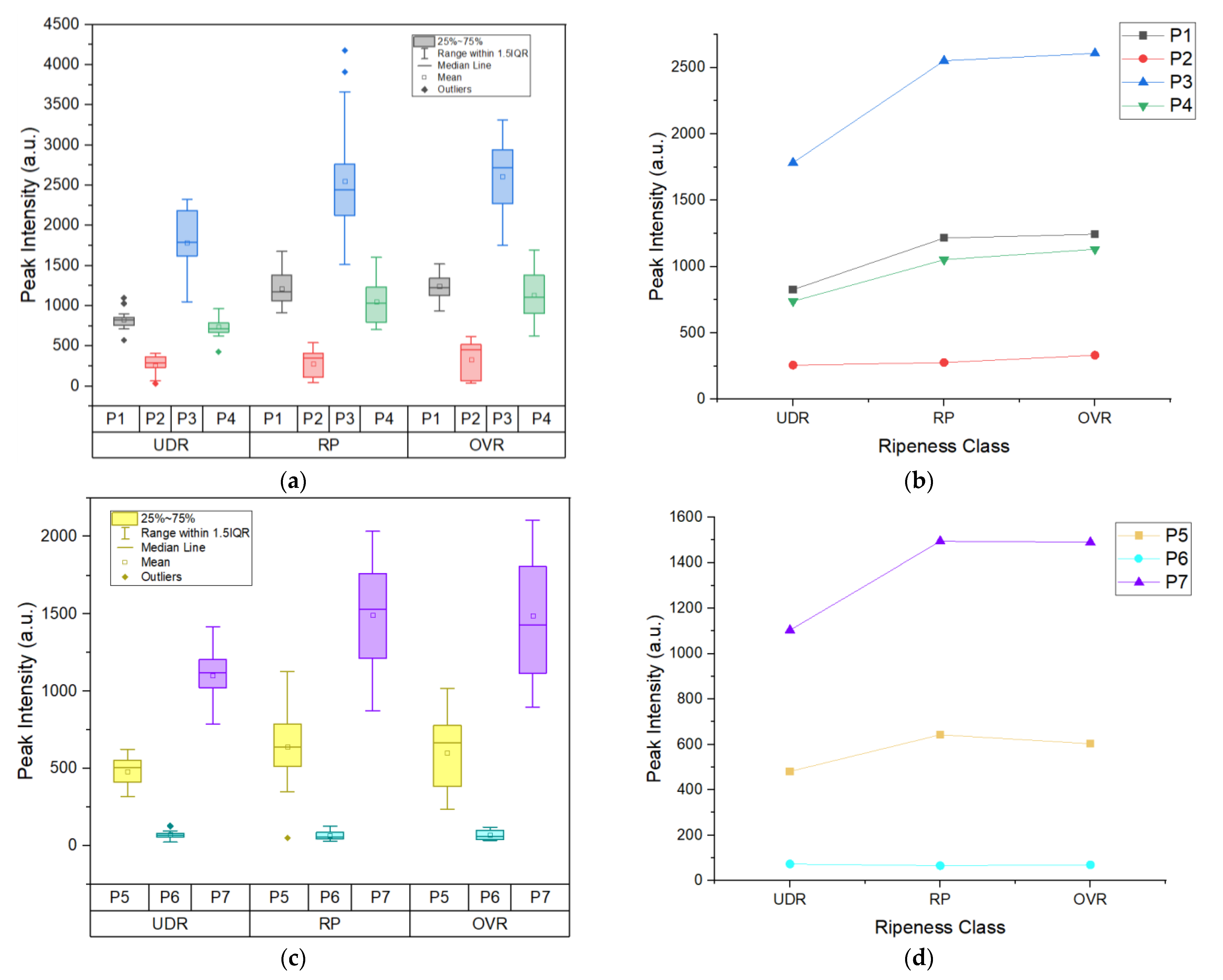


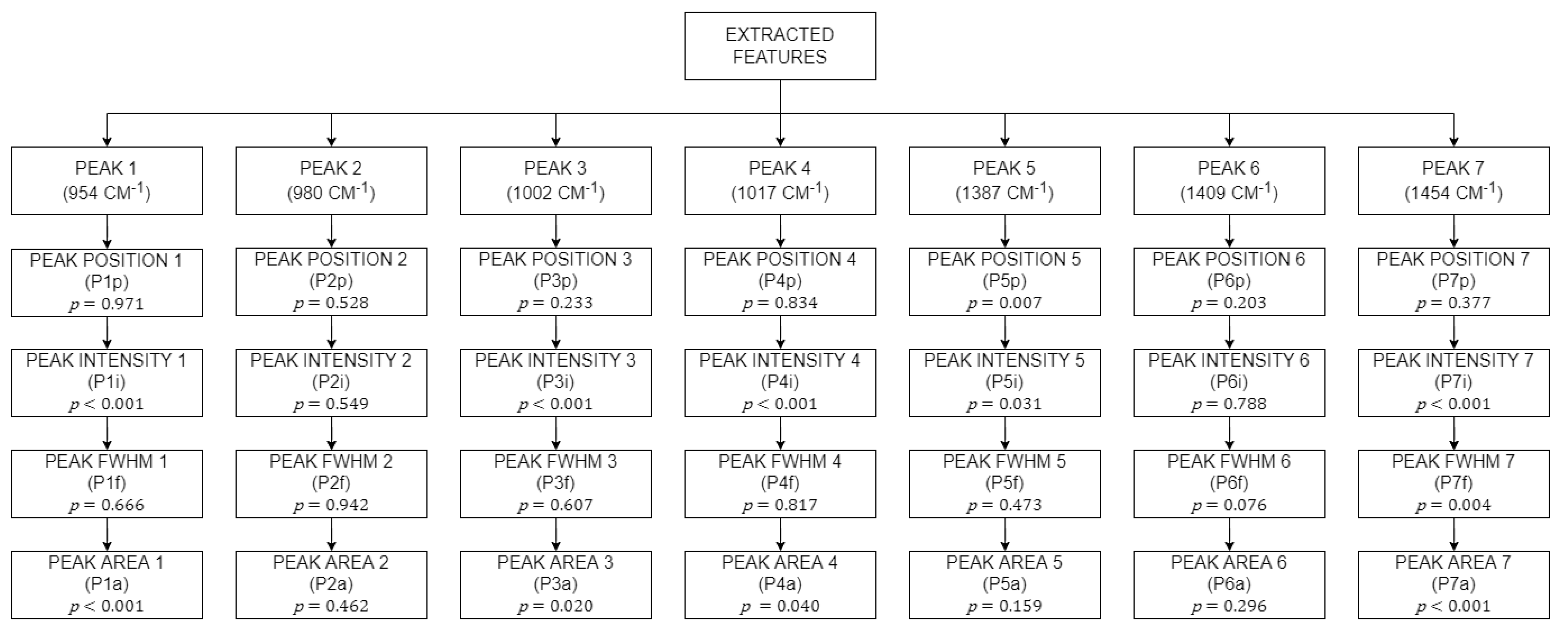
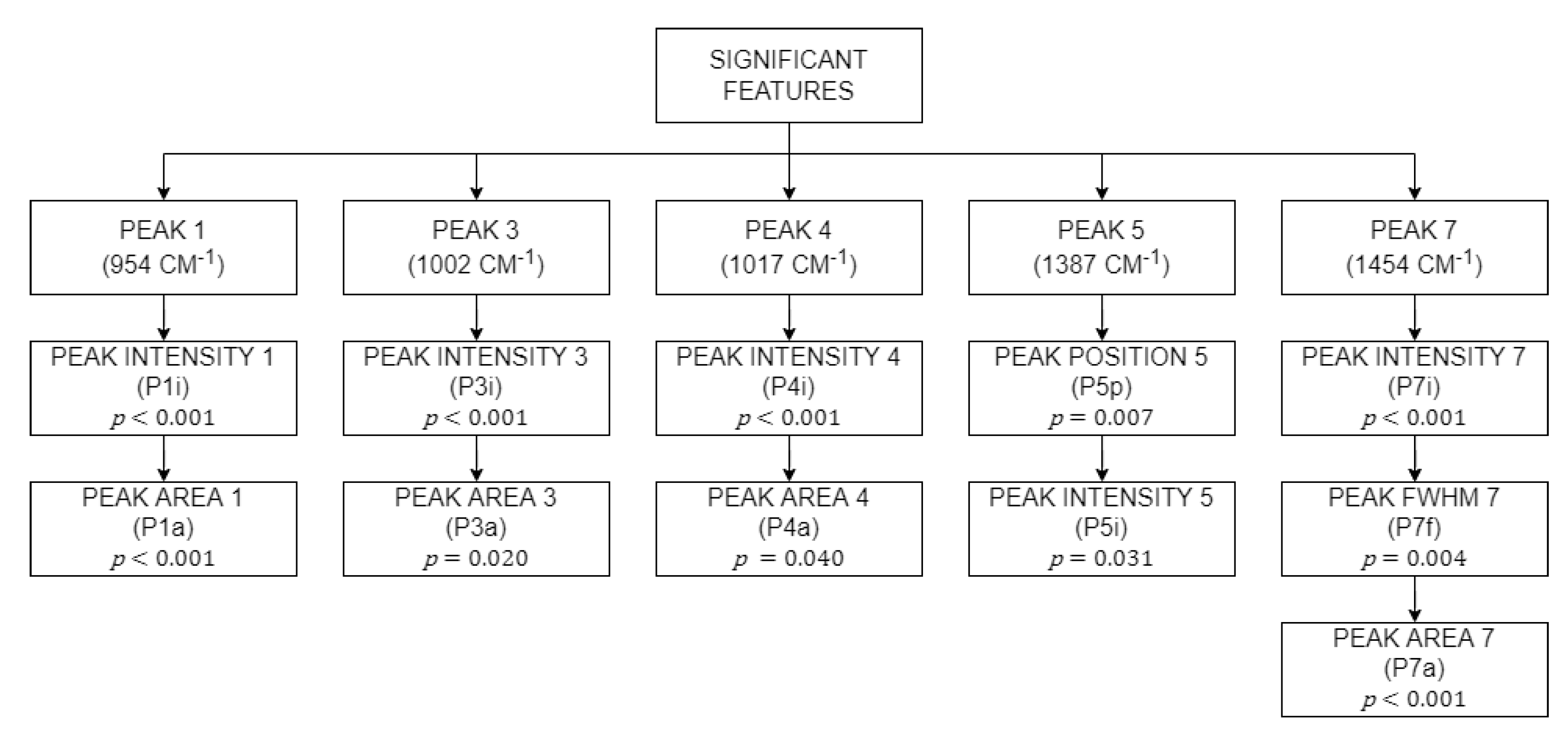
| Peak Number | This Study (cm−1) | Past Study (cm−1) | Molecular Assignment |
|---|---|---|---|
| 1 | 954 | 957–958 | β-carotene [8,12,16] |
| 2 | 980 | 984–985 | Chlorophyll-a [12,13] |
| 3 | 1002 | 1002–1006 | β-carotene [7,12,17,18] |
| 4 | 1017 | 1012–1016 | Amino acid [19,20,21] |
| Peak Number | This Study (cm−1) | Past Study (cm−1) | Molecular Assignment |
|---|---|---|---|
| 5 | 1387 | 1389–1395 | β-carotene [7,12,14,16] |
| 6 | 1409 | 1416–1418 | Cuticular Wax [15,22,23] |
| 7 | 1454 | 1447–1456 | Lycopene/β-carotene [14,16,24] |
| Classifier | Predictor | Accuracy |
|---|---|---|
| Medium KNN | P1i, P4i, P5p, and P7f | 90.9% |
| Weighted KNN | ||
| Trilayered Neural Network | ||
| Weighted KNN | P1i, P1a, P3i, P3a, P4i, P4a, P5p, P5i, P7i, P7f, P7a | 81.8% |
| Discriminant Ensemble |
| Classifier | Technique | Accuracy | Ref. |
|---|---|---|---|
| KNN | Sobel Edge Detection | 65.0% | [30] |
| CNN | Image Processing | 98.0% | [31] |
| ANN | Hyperspectral | 95.0% | [6] |
| ANN | Image Processing | 70.0% | [32] |
| LDA | Near Infrared | 81.0% | [33] |
| SVM | Image Processing | 98.9% | [2] |
| KNN | Raman Spectroscopy | 90.9% | This study |
Publisher’s Note: MDPI stays neutral with regard to jurisdictional claims in published maps and institutional affiliations. |
© 2022 by the authors. Licensee MDPI, Basel, Switzerland. This article is an open access article distributed under the terms and conditions of the Creative Commons Attribution (CC BY) license (https://creativecommons.org/licenses/by/4.0/).
Share and Cite
Azmi, M.H.I.M.; Hashim, F.H.; Huddin, A.B.; Sajab, M.S. Correlation Study between the Organic Compounds and Ripening Stages of Oil Palm Fruitlets Based on the Raman Spectra. Sensors 2022, 22, 7091. https://doi.org/10.3390/s22187091
Azmi MHIM, Hashim FH, Huddin AB, Sajab MS. Correlation Study between the Organic Compounds and Ripening Stages of Oil Palm Fruitlets Based on the Raman Spectra. Sensors. 2022; 22(18):7091. https://doi.org/10.3390/s22187091
Chicago/Turabian StyleAzmi, Muhammad Haziq Imran Md, Fazida Hanim Hashim, Aqilah Baseri Huddin, and Mohd Shaiful Sajab. 2022. "Correlation Study between the Organic Compounds and Ripening Stages of Oil Palm Fruitlets Based on the Raman Spectra" Sensors 22, no. 18: 7091. https://doi.org/10.3390/s22187091
APA StyleAzmi, M. H. I. M., Hashim, F. H., Huddin, A. B., & Sajab, M. S. (2022). Correlation Study between the Organic Compounds and Ripening Stages of Oil Palm Fruitlets Based on the Raman Spectra. Sensors, 22(18), 7091. https://doi.org/10.3390/s22187091






